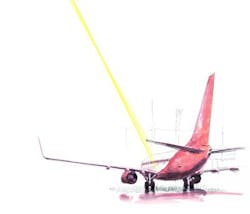Lasers are a gentler, more efficient means of removing paint from aircraft
The Hague, Netherlands - Airlines regularly strip the paint off their aircraft and then apply a fresh coat, often using chemicals or abrasive methods such as sandblasting to do so. The problem is that these techniques are expensive, time-consuming, and produce large quantities of waste, to name some of the disadvantages. In addition, some of the new materials used to build aircraft are very sensitive to chemical and mechanical cleaning methods, so aircraft manufacturers are increasingly seeking gentler and more precise techniques.
Related: Robotic laser paint stripper wins an Edison Award
So, LCR Systems B.V. (Hoogerheide, Netherlands) will develop what it calls a “laser paint removal robot” by 2016, which would use a laser to strip all the paint off an aircraft in a completely automated process. The company says it will be compatible with all types of aircraft and markedly superior to competing products in terms of cost and performance. At the heart of the system is an extremely powerful CO2 laser, which is TRUMPF’s contribution to the project. This laser and a robot arm will be mounted on a mobile platform. The idea is that the platform will travel around the aircraft, permitting the laser to remove all the paint. A traditional laser with a tube-type HF generator would not provide reliable performance because of the movement of the platform and would also take up too much space. TRUMPF has therefore chosen a transistor-based generator for this application. The laser is significantly smaller and more rugged, making it the perfect choice for use on the mobile platform.
To keep the surfaces from being damaged, the laser will be carefully programmed to selectively remove one or more paint layers. An optical sensor will distinguish between variations in the colors of the layers and transmit this information to the laser control unit to regulate the laser power. A CO2 laser is a particularly good choice for stripping the paint off an aircraft because its long wavelength lets it remove a broad range of different paints with similar levels of ablation efficiency. LCR is hoping that its laser paint removal robot will reduce the time required for aircraft paint stripping by 30%. In the case of larger aircraft, this method would save two whole days of work. Other positive effects of the new technique include an 80% reduction in the costs for each aircraft, clean extraction of the gases, and a reduction of the CO2 footprint by 90%.

